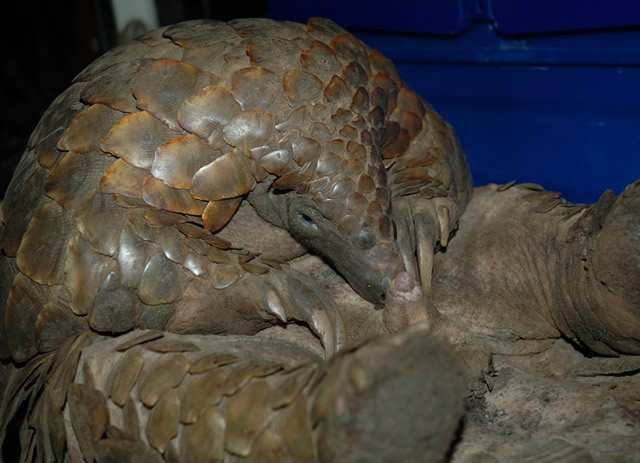Make way for the giant ground pangolin!

The giant ground pangolin (Smutsia gigantea) is the largest of all the eight pangolin species. These pangolins can reach lengths of up to 1.8 meters (nearly six feet).
The heaviest pangolin ever recorded was a giant ground pangolin, which weighed a whopping 33 kilograms (72.6 pounds)!
The giant ground pangolin inhabits lowland tropical moist and swamp forests, and can also be found in mosaic habitats comprised of forest, savanna, and agricultural lands.
As the name suggests, this is mainly a terrestrial creature that can be found in the daytime resting under piles of plant debris, in thickets, under tree roots, in partially opened termite mounds, or in burrows.
Giant ground pangolins feed on the typical pangolin diet of ants, termites, and other insects.
Unfortunately, some people throughout this species’ range superstitiously believe that pangolin scales and other body parts can be used to generate rain, neutralize evil spirits, and to ward off lions.
- IUCN Conservation Status: Near Threatened (since 2008)
- Range: West and Central Africa, including Cameroon, Central African Republic, Congo, Democratic Republic of Congo, Côte d’Ivoire, Equatorial Guinea, Gabon, Ghana, Guinea, Guinea-Bissau, Kenya, Liberia, Senegal, Sierra Leone, Tanzania, and Uganda. Its presence is uncertain in Angola, Burkina Faso, Niger, Nigeria, Sudan, and Togo.
- Protection: Present in many protected areas and protected from international trade under CITES Appendix II
Smutsia gigantea is now regionally extinct in Rwanda.
Although there is no reliable information on the giant ground pangolin’s population abundance nor densities, the species has likely undergone a decline of 20 – 25% over the last 15 years, mainly due to bushmeat hunting and for use in traditional medicines and cultural rituals.
Like other pangolins, the giant ground pangolin’s solitary, secretive, and nocturnal nature makes it difficult for scientists to study and count.
More research on this animal is certainly needed. Additionally, there is a pressing need to develop and enforce protective legislation throughout its range, in order to ensure a secure future for the giant ground pangolin.
Sources: “Smutsia gigantea,” International Union for the Conservation of Nature, accessed 29 January, 2012. “Giant Ground Pangolin (Smutsia gigantea),” Arkive, accessed 29 January, 2012.
Image: By Marc from South Africa (Pangolin Waking Up) via Wikimedia Commons.


![Pangolin Trafficking: 2011 to October 2013 [Infographic]](http://pangolins.org/wp-content/uploads/2015/08/WorldPangolinDay2013-01-copy-150x150.jpg)
1 Comment
Comments are closed.